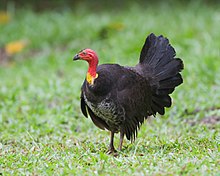Naturally occurring coating helps to fend off microbial invasion.
11 April 2014
The eggs of the Australian brush turkey (Alectura lathami) repel moisture that can harbor harmful microbes.
Australian brush turkeys incubate their eggs where few might — in moist piles of rotting vegetation. The eggs are kept warm by the heat generated as microbes in the soil and compost decompose organic matter, but those same microbes can also get through eggshells and kill the embryos.
 |
| Photo: Wikipedia |
Despite the risk, infections occur in only about 9% of eggs laid by Australian brush turkeys (Alectura lathami). Now researchers think they know why: the shells are covered in a layer of nanometre-sized spheres of calcium phosphate, which makes them more water-repellent than chicken eggs and helps them to fend off bacterial attachment and penetration. The results, published this month in the Journal of Experimental Biology1, could one day lead to new antimicrobial coatings for plastics and other surfaces.
Most eggshells create a tough barrier for pathogens to crack, and microbes that succeed encounter an antimicrobial enzyme called lysozyme, found in the whites of bird eggs. But brush-turkey eggs have roughly the same amount of lysozyme as chicken eggs, and their shells are 1.5 times thinner than those of chickens, which should make them more susceptible to invading microbes, not less.
No comments:
Post a Comment